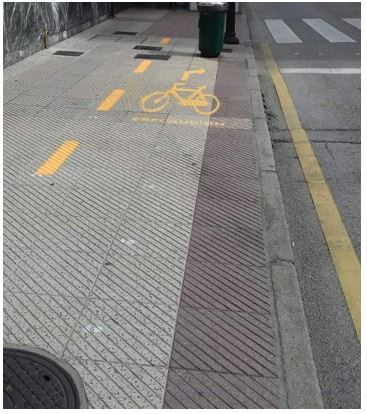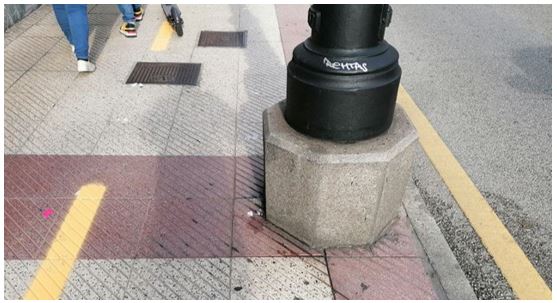Javier Ruiz Berciano
Currently, societies are moving towards a more sustainable and ecological way of life, a mentality that is materialized in the constant advances that take place in the field of renewable energy, electric vehicles, green hydrogen or energy storage. In European cities they tend more and more towards carsharing, electric scooters, green hydrogen and the use of electric bicycles. Bicycles (electric or not) are an economical and sustainable means of transport, especially useful for short, flat distances in cities crowded with traffic.
To this end, most large cities have developed a network of bike lanes, so that their users can use them without influencing motor vehicle traffic, thus avoiding a multitude of accidents. It is common for bicycle related accidents to occur every day. Obviously, compared to other vehicles, bicycles have a clear disadvantage and are usually much more affected than the other after the incident. For this reason, these “bike lanes” have been arranged in many localities.
The corresponding regulations will be discussed below when defining whether a road is exclusively for cyclists or whether they must share the road with other vehicles.
Annex I of Royal Legislative Decree 6/2015, of October 30, which approves the revised text of the Law on Traffic, Circulation of Motor Vehicles and Road Safety, in its sections 74 to 79, defines the different types of roads on which bicycles are allowed to circulate:
– Cycle path: It is equipped for bicycles with vertical / horizontal marking and they have an adequate width for their circulation.
o Bike lane: It is a type of cycle path, attached to the road (1 or 2 directions)
Protected bike lane: It is a type of bike lane that is, by means of lateral elements, separated from the road / sidewalk.
o Sidewalk-bike: It is a type of bicycle path, marked on a sidewalk. It is common, even if they are only for the circulation of bicycles, for pedestrians to cross them, generating a large number of incidents. Normally the signage is horizontal, with lines marked on the sidewalk.
o Track-bike: It is a type of cycle path separated from motor vehicle traffic.
– Cycle path: It is a path for pedestrians on which bicycles can circulate.
However, article 8.15 of the Highway Instruction Standard 3.1-IC of the General Directorate of Roads of the Ministry of Public Works, dated February 19, 2016, only mentions bicycle lanes adjacent to highways. It can be seen that the regulations that cities must follow to build cycle lanes is somewhat confusing, and even more so if one takes into account that each autonomy has its own legislation. Following the aforementioned article, when a road shoulder appears painted as a bike lane, it is not complying with the regulations, since it would force the rest of the vehicles that must use the road shoulder to circulate elsewhere, indeterminate. In these cases, the hard shoulder will continue to function as such, welcoming not only cyclists, but also animal-drawn vehicles, special vehicles with a maximum authorized mass of no more than 3,500 kilos, mopeds and vehicles for people with reduced mobility.
On the other hand, in Section 3 of the General Traffic Regulations, Article 64, it is determined that bicycles have priority of passage over motor vehicles, when they circulate on a bike lane or shoulder.
However, it is common to find in Spain a large number of alleged bike lanes that do not comply with the applicable regulations, forcing cyclists to expose themselves to dangerous situations crossing roads where they do not have priority, and forcing motor vehicle drivers to maintain extreme caution to avoid accidents related to bicycles.
In our country there are numerous examples of poorly executed roads of this type, endangering pedestrians, cyclists and drivers, and causing a multitude of accidents.
For example, in A Coruña, a discontinuous network of bike lanes has been developed, with abrupt or poorly signposted ends, which forces cyclists to go onto the road or sidewalk in order to continue on their journey, raising numerous complaints among citizens. If we also take into account the cars that park in double or triple row in the same areas, it can be concluded that the circulation of bicycles through the city is a challenge.
On many occasions, the bike lanes that run parallel to the road occupy the intersections, causing motor vehicles, when turning to their right, to cross these lanes perpendicularly, being able to run over the cycles that are in the neutral position of their mirrors. For this reason, there are many citizen institutions that advocate the installation of traffic lights with automatic proximity sensors to safely control this type of situation.
According to a study by the OCU, Las Palmas and Madrid have the worst bike lane layouts in Spain. These networks have a large number of design flaws. Many times they are disjointed, invade the sidewalks, do not have the appropriate width or are in a deplorable state of repair.
A case that concerns us in a special way is the temporary bike lanes in Oviedo. For its execution, the routes for cyclists were outlined with yellow paint using spaces in the backyard or the road. This caused that, not only the bike lanes occupied spaces designated for pedestrians or vehicles to motor, causing accidents, but also the path was infested with bins, traffic lights, streetlights, steps, etc. One more example of the little respect and interest that is put by public institutions in the use of the bicycle as a means of urban transport.

Image 1. Obstacle at the end of the Oviedo bike path

Image 2. Lamppost placed in the bike lane of Oviedo
[1] http://www.aviewfromthecyclepath.com/2011/05/state-of-art-bike-way-design-further.html
